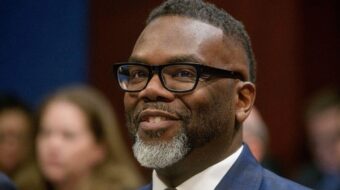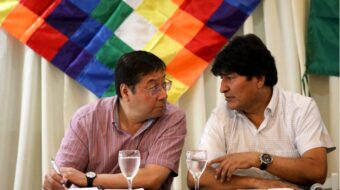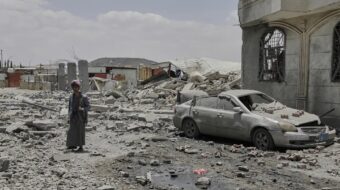
Everything looked different as we landed in Santiago Chile last month. The Andes Mountains were still awesome, even if the snow cap is shrinking. Just a few miles away, the Pacific Ocean still sparkled blue. The craggy hills that Charles Darwin adored still rose abruptly in the center of this city of 6 million. But the skyline had changed beyond recognition. Tall office buildings serving transnational companies, smooth-running Metro trains and modern highways give Santiago a new look.
“Poor people from the slums outside Santiago don’t even come into the city,” Nancy Diaz, a French teacher, told us. “The police don’t want them here and they harass them.” When we asked where the slum residents worked, Diaz said, “They work for low wages in factories outside the city. And many are unemployed.”
It was our first visit to Chile since June 1973. Then we had to flee the country when military violence broke out against the elected government of the Socialist president, Salvador Allende.
A few months later, on Sept. 11, a murderous military coup overthrew the elected government. The United States was deeply involved. The U.S. Navy held a joint exercise with the Chilean Navy on Sept. 10. Thousands of workers and students were killed in the coup.
The bloody military dictatorship lasted over 16 years. In 1990, after losing a plebiscite, a deal was negotiated. General Augusto Pinochet stepped down from his self-appointed presidency. But he left the fascist constitution in place and a military with greatly expanded powers.
A time of hope
We had picked a good time to visit Chile, March 2006. Hope was in the air. Michelle Bachelet, elected by a center-left coalition, had just been installed as president. She is the first woman to become president of Chile. As our friend, Nery Barrientos, told us: “Her election has created a new and very positive environment. Historically, the progressive forces never got a majority among women. But now that has changed. There is a strong chance that it is going to stay that way.”
Other progressive South American presidents were there to greet Bachelet. They included Evo Morales of Bolivia, Nestor Kirchner of Argentina, Tabare Vasquez of Uruguay, Luiz Inacio Lula da Silva of Brazil, and of course, Hugo Chavez of Venezuela. Bachelet has moved quickly to cement ties with her progressive neighbors.
She also met with leaders of the Communist Party of Chile to thank them and discuss the next steps. The Communist bloc of votes gave Bachelet the margin she needed to win the election.
The Communist votes were also decisive in electing the previous president, Ricardo Lagos. But he ignored it. Communist support of Bachelet was based on the key issues of labor rights, proportional representation, restoration of pensions, reparations to families whose loved ones were persecuted or killed by the dictatorship and prosecution of those guilty. There was general agreement with Bachelet on all of these issues.
To win these demands, the Communist Party of Chile has called for continued mass actions in the communities and workshops.
We visit the Central Labor Federation
As union activists, our first visit was to the labor federation, the CUT (Central Unitaria de Trabajadoras). The center was jammed with workers having meetings during their lunch time. Inside the long courtyard, a strong mural in vivid colors dramatized the workers struggle.
Jose Manuel Diaz, CUT’s national secretary for international relations, was preparing for a trip to China the very next day. But he took a few minutes to explain: “We lost a whole generation in the 16 years of the military dictatorship,” he told us. We were to hear this dramatic statement again and again from teacher leaders, Communist Party activists, transit workers and others. The known executions and assassinations of teacher union leaders, alone, numbered 112.
“Now we are rebuilding,” Diaz told us. “We have 800,000 members.” CUT influence goes way beyond their numbers. They are the major force fighting to restore the right to organize. A recent survey of nonunion members showed that 40.5 percent did not belong because there was no union they could join. Another 27.6 percent were afraid to join a union for fear of being fired.
Many repressive laws of the Pinochet dictatorship are still in effect. For example, union leaders as well as officers of community and social service organizations are not allowed to run for the national Parliament. Teachers unions and others are not allowed to bargain collectively. The national election districts were distorted to keep the right wing in power. With only 34 percent of the vote, they are guaranteed half of the seats in Parliament. Until last year, some of Pinochet’s senators held their positions for life.
Restoring labor rights is the number one issue for CUT. Restoring workers’ pensions is another major issue. Under the military dictatorship, social security pensions were privatized. The generals and the banks pocketed billions of these funds. The national pension fund now has US $63 billion. It is funded by 10 percent of workers’ wages and an additional 1 percent (yes, only 1 percent) paid by the employers. Another 9.5 percent of the wage is deducted for health, disability and life insurance. Consumer prices are relatively high in Chile. Still many earn only the minimum wage, less than US $250 a month.
Six private insurance companies manage the pension funds at a high rate of profit for themselves. For the workers, it is a disaster. Some companies have deducted the 10 percent from workers’ pay but kept the money for themselves. They have gotten away with this to the tune of US $450 million. As now set up, 43 percent of Chile’s workforce will collect no pension at all when old age forces them to retire. Of those covered, half will get only the minimum pension which is below the poverty level. The Chilean workers sent us a message, “Don’t let them privatize your Social Security.”
As we left Chile at the end of March, pensions were in the newspaper headlines again. President Bachelet was calling for a raise in the minimum pension level. That will not be easy to win. According to El Siglo, the Communist Party weekly, the people Bachelet appointed to the Pension Board are well liked by the banks. Workers are not represented. It will take lots of popular pressure, writes El Siglo, to win better pensions.
Chileans know how to have a good time
We were invited to a dinner in honor of Volodia Teitelboim on his 90th birthday. Teitelboim, noted writer, poet and Communist, was elected to the Senate during the Allende government. Over 600 people attended the dinner, including well known cultural and political leaders.
The music was beautiful and Teitelboim’s speech inspiring. But one face burned its way into my heart. I see her in my dreams. It was the face of Ana Gonzalez Recabarren, the woman whose husband, two sons and daughter-in-law were murdered by the dictatorship. Her daughter-in-law was pregnant when she “disappeared.” It was the face of a woman who still holds her head up high. She continues the struggle for that which her family gave their lives — a better Chile. It was not the face of a woman who was alone. Her comrades were all around her.
On the following weekend, a popular picnic brought whole families out to the park to celebrate Teitelboim’s 90th birthday. On a large outdoor stage, costumed dancers offered us the dances of Colombia and Argentina. The audience applauded. Then a dance group took out their large white handkerchiefs that floated like birds’ wings. When they did the cueca, the national dance of Chile, the audience went wild. As Che Guevara noted in his “Motorcycle Diaries,” Chilean culture is warm and welcoming. Chileans sure know how to have a good time.
A land of poets
Chileans are justly proud of their two Nobel prize-winning poets, Gabriela Mistral and Pablo Neruda. Neruda was also a Communist, elected as a senator in 1945, during the González Videla presidency. When he protested the president’s repression of striking miners in 1947, Neruda was persecuted. He was driven into exile by the same president he had helped elect.
Neruda’s poetry has inspired generations of people around the world. One of the first places we visited was “La Chascona,” Neruda’s house built into a hillside in Santiago.
Neruda had a special feeling for the sea and the ships that sail the sea. It was a passion he indulged only on land, sometimes in sight of the ocean.
There were many beautiful things in La Chascona, including figureheads and other parts for ships. Neruda was a noted collector. World famous painters gave him presents of their work. There had been an even larger collection before the military ransacked the house after the 1973 coup. As we looked at samples of Neruda’s handwriting, a familiar name jumped up: Milton Rogovin! It was Neruda’s note of warm praise for Rogovin’s photography when the two of them met in that very same house. Just a few weeks before our visit, Rogovin’s work was featured in the People’s Weekly World. We felt connected.
With the help of Nery Barrientos and Lucia Elias, Chicago friends who had returned to live in Chile, we visited the other Neruda homes. “La Sebastiana” looked out on the busy port of Valparaiso. Actually, Neruda spent most of his time at his home in Isla Negra, which is right on the ocean. He could hear the waves breaking on the rocky shore. It was there that Neruda was lying, sick in bed, when soldiers broke into his home during the 1973 coup. He died a few days later.
The professional guides at the Neruda homes gave an excellent tour of his collections of artwork, mollusks and ship’s furnishings. But they never mentioned his political work as a senator and Communist. It reminded me of a visit I made to the Spanish museum housing Picasso’s “Guernica.” A class of schoolchildren was visiting at the same time. Not once were they told who had bombed Guernica (the Franco fascists) and what that war was about. “The same thing is true of the textbooks here,” Barrientos told us. “Pinochet is listed as a president, but he was never elected. You cannot just declare yourself president!”
Venceremos: We will win!
We left Chile optimistic about the future. When Gladys Marin, head of the Communist Party of Chile died, 1 million people came to her funeral. Marin was honored for her leadership and heroism in continuing the struggle after the military murdered her husband. From what we learned on this trip, we are convinced that the truth will come out. It is a long struggle but the Chileans will regain their democratic rights and restore their history.
Beatrice Lumpkin (bealumpkin@aol.com) is a leader of Illinois Alliance of Retired Americans and a longtime activist in South Chicago and among steelworkers. Lumpkin wrote “Always Bring a Crowd,” a book about her steelworker husband, Frank Lumpkin.









